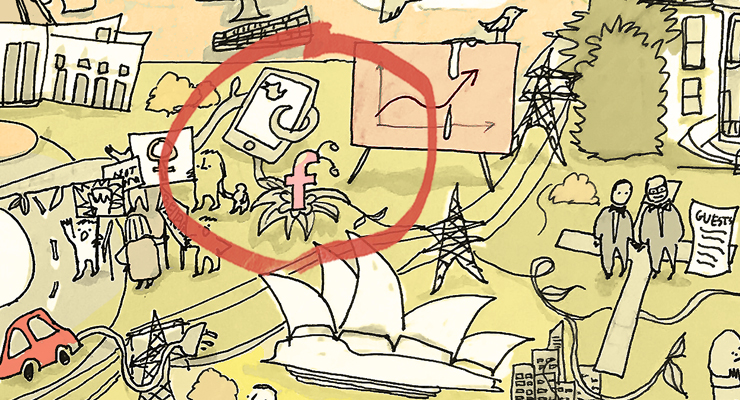Scott Morrison’s proclivity for playing fast and loose with the truth extends, naturally, to his social media presence. And the worst thing is, he’s often rewarded with more engagement.
It’s said that a lie can travel halfway around the world while the truth is still lacing up its boots.
Social media has supercharged the speed and scale of lies. Much of the discussion about misinformation and disinformation on social media focuses on the obvious fake news pedallers and grifters. But what about the habits of our own political leaders?
Crikey’s A Dossier of Lies and Falsehoods: How Scott Morrison Manipulates the Truth lays out the case that Australia’s prime minister is happy to play fast and loose with the truth when it suits him. Naturally, this proclivity extends to his social media habits.
Scott Morrison is a keen user of social media. He and his team use it to directly reach voters with information about new policies, his government and himself.
Over the past year, Morrison’s accounts have posted an average of almost two times per day. Using carefully chosen snaps taken by his personal photographer, the prime minister’s social media accounts show a carefully crafted image of a man who is part-daggy dad, part-respected leader.
A closer look at what Morrison has posted about Australia’s vaccine rollout — the subject of a lie and a falsehood captured in the dossier — shows how people respond to his promises and how far they go, even when they turn out to be false.
Promises more popular than the truth
Morrison has posted to social media about vaccines more than 50 times in the past year. How much people have engaged with those posts varies on a number of factors — including whether it was true or not, it seems.
The number of Facebook engagements (likes, shares and comments) on a post tells us just how many people have responded to a piece of content. It can also be used as a rough proxy for how many people saw the post. Facebook’s algorithmic feed prioritises content that’s engaging, meaning something that’s interesting is likely to be shown to more people.
Knowing this, it’s possible to surmise that Morrison’s optimistic posts prior to vaccine rollout — particularly those promising that Australians will be first in line to get their COVID-19 vaccinations — were generally more engaging and seen by more people than his posts about the rollout’s execution.
Morrison’s most popular Facebook post was a livestream of a press conference where the prime minister announced that the government had secured a deal with AstraZeneca to obtain their vaccine candidate.
More than 220,000 people watched his announcement, in which Morrison promised that Australians would be “among the first in the world to receive a COVID-19 vaccine”. That turned out to be false.
Of Morrison’s top 10 Facebook posts by engagement numbers, only two were posted since the vaccine rollout started: one about the first person in Australia to receive a vaccine and another about the first frontline workers to get their jabs.
Since then, Morrison’s posts about Australia’s maligned vaccination rollout have proven to be significantly less popular.
His least engaging vaccine post was made earlier this month when he said that just 3 million doses had been administered to Australians, significantly behind where rollout was initially projected to be. Other unpopular posts included further updates and announcements about where people could get their jabs.
While other factors affect this engagement (posts of graphs are generally less engaging than live video, for example), the general trend suggests that Australians are more enticed by lofty promises than they are with the disappointing execution of Australia’s vaccination scheme.
Lies and falsehoods travel beyond their original post
Social media analytics also allows some insight into how far these messages can go, regardless of whether they’re true or not.
Beyond the hundreds of thousands of views of Morrison’s initial post about the AstraZeneca deal, reposting of similar rhetoric allowed the message to carry further.
Social media analytics tool CrowdTangle is limited to searching posts from Facebook pages (i.e. official accounts and not personal accounts used by most people) and so can only give us a limited picture of what’s happening on the platform.
It shows a search for “Australians will be among the first in the world to receive a COVID-19 vaccine”, a message used repeatedly by Morrison on social media and elsewhere, was posted by other pages nearly 100 times in the week since the initial AstraZeneca announcement.
These posts, shared by accounts ranging from the Liberal Party of Australia’s official account and news outlets’ pages to community pages such as Explore Melbourne, had 49,000 engagements during this time.
What this shows is not just that social media platforms like Facebook allow Morrison to spread lies and falsehoods faster and further, but they also reward him for doing so.

Help us keep up the fight
Get Crikey for just $1 a week and support our journalists’ important work of uncovering the hypocrisies that infest our corridors of power.
If you haven’t joined us yet, subscribe today and get your first 12 weeks for $12.
Cancel anytime.
Peter Fray
Editor-in-chief of Crikey








